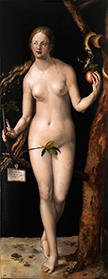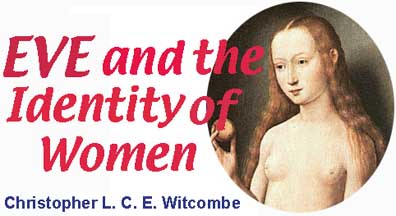|
||||
|---|---|---|---|---|

Eve
|
1. Eve and Women
Art has always played and continues to play, an important role in the service of what has been called "gender ideology," communicating ideas about social order through the representation of female and male sexuality. The themes and styles of works of art often function as a prescription for relationships between women and men.
Images of women and men can effectively incite both sexes to adopt certain self-images, attitudes, and behaviour. Male-constructed images of women, and men, are so embedded in Western culture that they appear quite "natural." Once it is recognized that they are constructions, it becomes necessary to ask not only how they are constructed but also why.
The constructed social relationship between women and men in the West is rooted in the Genesis story of Adam and Eve. For the last 2,500 years it has underpinned our perception of sex and gender and thereby influenced how women and men are represented in art. Any discussion of images of women and men must therefore be prefaced by an examination of the opening chapters of Genesis.
The story of Adam and Eve is a creation story, and creation stories, which are accounts of how humankind came to be, can reveal a great deal about the ethos of the culture. Stories or legends about the origin or creation of humankind offer clues about how a culture perceives the world and the relation of living things to it and to each other.
The "message" of the Judaeo-Christian creation myth, recounted in the Biblical story of Genesis 1-3, shows a particular conception of the origins of humankind. It is claimed that God created man in his own likeness, was given dominion over "every living thing", and leave to subdue the earth with his offspring. Equally significant is the prominence given to men; God is male and his most important creation is male. The story stresses the primacy of man and the centrality of his place in the universe, while making it clear that women play a subordinate role. The story also recounts how the woman, whom Adam subsequently named Eve, was disobedient and succumbed to temptation the result of which was the expulsion of both Adam and Eve from the Garden of Eden.
For the past two thousand years or so the story of Adam and Eve has communicated social and religious values to Western civilization. Whether you regard the story as an innocuous folk tale or as an invidious, misogynistic tract, it has successfully presented its "truths" about women in particular as God-ordained and universally valid.
Throughout the Christian period, the story of Eve has provided men with the reason why they should restrain and restrict the social, sexual, religious, political, and economic freedom of women. It has also given men the justification to hold women responsible for all the misfortunes suffered by mankind.
All women are like Eve, and their only chance of redemption is to become like the Virgin Mary, another patriarchal fantasy, who represents absolute obedience and purity. The story of Eve and its many misogynistic interpretations have over the centuries defined the image of woman in Western civilization.
An earlier version of this essay appeared originally in Images of Women in Ancient Art
Copyright © (text only) 2000. Christopher L.C.E. Witcombe
|
|||


